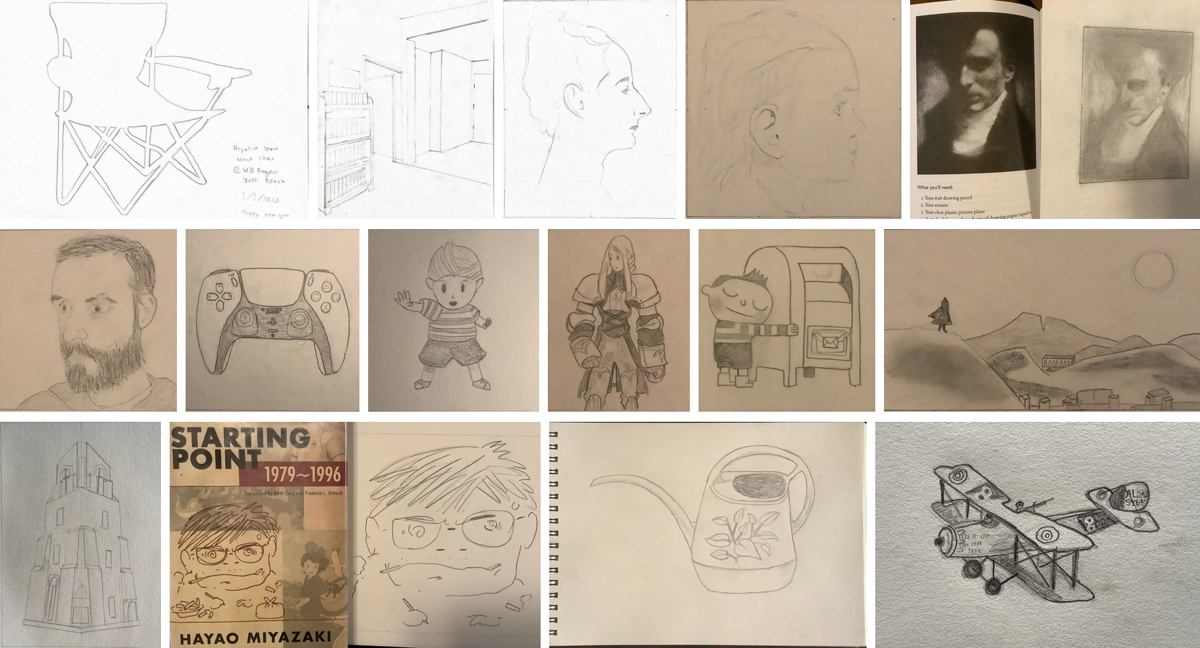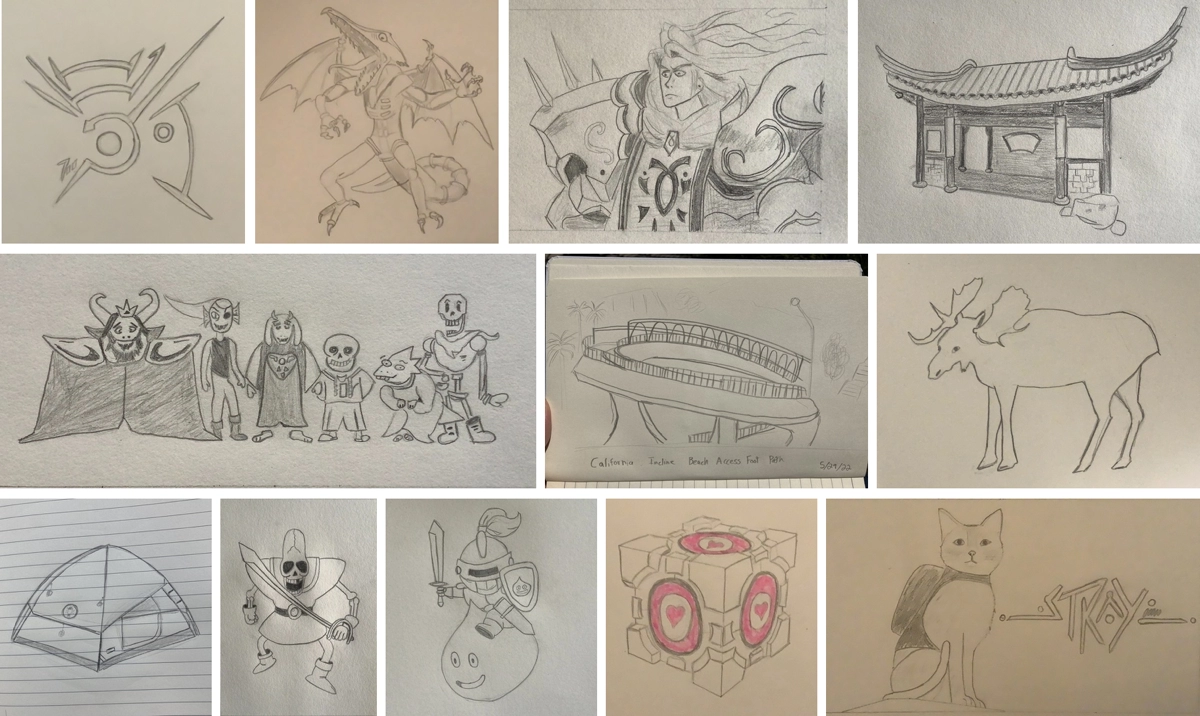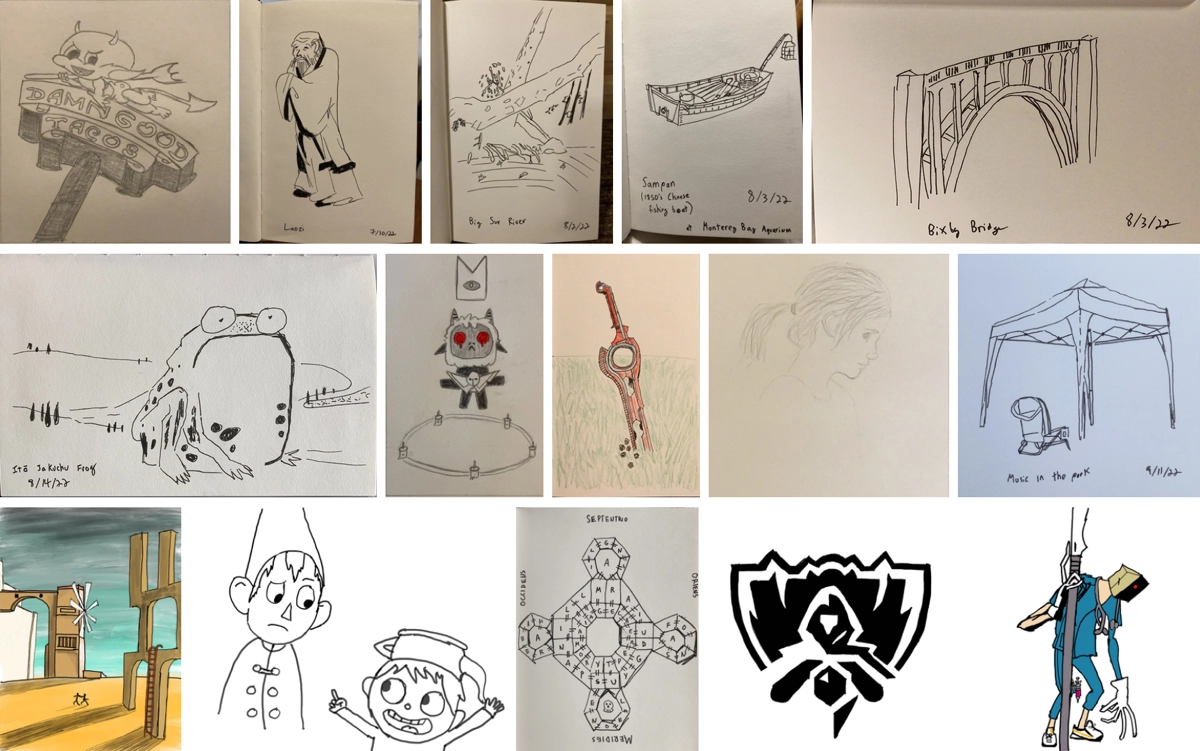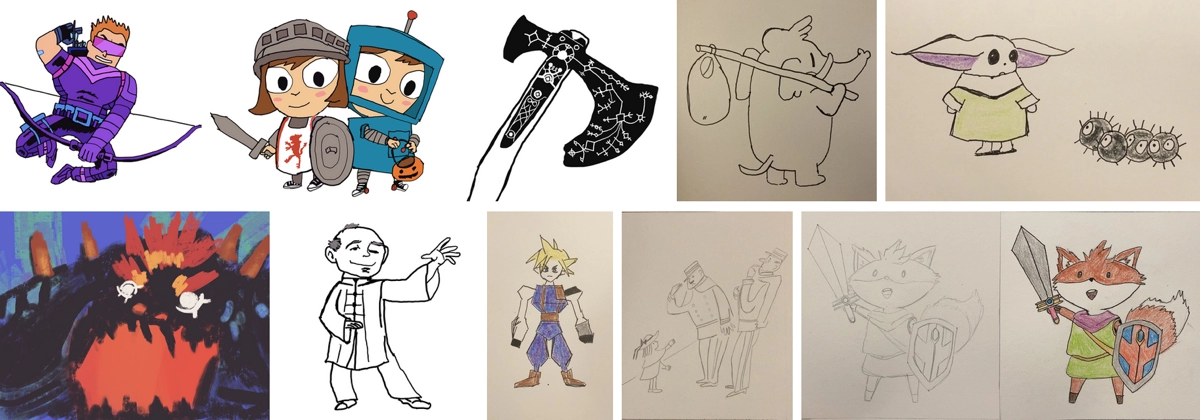
At the beginning of 2022, I embarked on a project of drawing once per week for the entire year. On Christmas day I completed my 52nd and final sketch.
Among all the possible hobbies out there, why pursue sketching? I think on some level it’s an opportunity to revisit a beloved childhood hobby. Growing up in Quebec, I pored over my local library’s collection of Franco-Belgian bandes dessinées and Japanese manga imported from France (before it was widely available in English), then spent hours trying to recreate Akira Toriyama’s spiky-haired characters and incredible action shots. When this passtime suddenly became embarrassing in my self-conscious teenage years, I abandoned it entirely.
The more recent and direct inspiration for this project was visiting the Hayao Miyazaki exhibition at the Academy Museum last fall. I was familiar with the lavish storyboards he drew for his films, which only became more stunning in the final animation. However, what really struck me while touring this exhibition were Miyazaki’s preproduction sketches: the raw first drafts of characters and locations done in simple pencil and watercolours. While I could never aspire to be an artist on Miyazaki’s level, being able to share ideas visually in this simple manner seemed like an incredibly practical creative skill, and during that visit I developed the aspiration to cultivate it.
(I’ve also long noted sketching as a hobby among game developers I admire, including Brendon Chung, Adam Saltsman, and Derek Yu.)

I began my pursuit by reading “Drawing on the Right Side of the Brain” by Betty Edwards, which came highly recommended for people with an engineering background like myself. I appreciated the way she broke down the skill of drawing into components that gradually built on each other (edges, spaces, relationships, light & shadow, the gestalt), and I enjoyed completing the exercises provided with each chapter.
Edwards also provided another argument for learning to draw. Her perspective is that drawing is “basic to training visual perception”. To draw with correct proportion and perspective, you have to ignore the preconceived ideas of spatial relations from your “left brain” and rather see things as they actually are. Familiar objects acquire unintuitive properties when projected from three dimensions to two. Developing this way of seeing is a core building block skill for all “right brain” creative work1, and is therefore inherently valuable.
“Drawing used to be a civilized thing to do, like reading and writing. It was taught in elementary schools. It was democratic. It was a boon to happiness.” – Betty Edwards, Drawing on the Right Side of the Brain
Finally, in structuring this particular challenge for myself, I drew from books such as “Atomic Habits” by James Clear, “Ultralearning” by Scott H. Young, and the works of Cal Newport. All three authors explore best practices for self-directed learning, and suggest strategies for maintaining progress and motivation. As someone with a busy schedule and prone to being fickle about new hobbies, I sought to structure my practice in a way that I could stick with for an entire year.
Clear’s book in particular suggests that common wisdom about motivation is backwards. The standard assumption is that you show up regularly to practice because you are motivated to do so. However, motivation is capricious, and easy to lose when you’re rarely seeing visible progress. Rather, Clear suggests that the goal should be to regularly engage with the skill you want to learn. This act of showing up on schedule with or without motivation develops a habit. Habits become deeply rooted, to the point where they no longer require extrinsic motivation.
“So, yes, perseverance, grit, and willpower are essential to success, but the way to improve these qualities is not by wishing you were a more disciplined person, but by creating a more disciplined environment.” – James Clear, Atomic Habits

Based on this principle, I designed my personal challenge around simply showing up and drawing. I didn’t need to take on progressively more complex subjects, or regularly adopt new techniques. I didn’t have to spend a particular amount of time completing my work. The goal was simply to complete one sketch per week for the entire year. They didn’t even have to be completed on schedule, though I tried never to float more than two per weekend.
In terms of equipment, I started with a set of drawing pencils, an eraser, a ruler, a protractor2, and a large 9″x12″ pad of paper. To truly capture the inspiration of my youth, I even managed to locate my childhood Dragon Ball pencil tin. Following directions from Betty Edwards and others, I began drawing faint practice lines with a 6H pencil until I got the shape I wanted, then went back and passed over with a darker HB at the end. At first this process was quite tedious: draw, erase, draw, erase, trial and error until the desired curve emerged. Gradually I developed some muscle memory that helped speed up the process.
One limitation of this setup was that it wasn’t very portable. Drawing this way basically required a tabletop setup, and sometimes I wanted to sketch while out in the world. In my search for inspiration, I chanced upon the book “Sketch Now, Think Later” by Mike Yoshiaki Daikubara. He demonstrated the amazing urban ink drawings he drew on location while travelling, optionally adding watercolours afterwards. Inspired by his work, I purchased a little 5½″x8½″ handheld notebook and a waterproof Pigma Micron 10 pen; I adore both. I love getting to draw when the mood strikes while travelling, and how pen drawing forces you to keep moving fluidly and creatively incorporate errors.
My final piece of sketching equipment was a digital pencil for my iPad Mini. I’ve used it to dabble in Procreate, though I haven’t started seriously learning its functionality yet. With layers, brushes, and unlimited undo, digital drawing certainly has the least friction of the three options. However, I find myself missing the fine-grain pressure control that physical drawing affords. The digital simulation isn’t quite as intuitive, or perhaps it requires some additional calibration.

“The easiest way to learn directly is to simply spend a lot of time doing the thing you want to become good at.” – Scott H. Young, Ultralearning
Between pencil, ink, and digital drawing, I completed my 52 weekly sketches. However, as I reflect back on this year-long project, I’m somewhat ambivalent about whether to consider it a success. Ostensibly, I achieved what I set out to do, and stuck with it despite a busy schedule and varying levels of motivation. It’s difficult to see any clear linear progression in drawing skill, but I certainly feel more comfortable and adept than I did at the start. I also generally had a nice time while sketching, it was a quiet relaxing contemplative hobby.
In a broader sense, however, my original inspiration for learning to sketch was being able to communicate ideas visually. I want to develop a practical skill for collaborating with others in the context of making a video game or other creative project. Contemplating this ultimate goal makes me question my learning strategy. Is copying from visual reference the best way to improve? Or should I structure my practice to more directly target creating original art? What is the next set of core skills I should seek to develop?
I’m still grappling with these questions, but I feel quite upbeat about this format of structured, regular practice, and I’m keen to see what other skills might be amenable to this sort of yearly project. Here’s to continuing to grow and learn in 2023.

1. I’m a bit skeptical of the left/right brain distinction, but I’ll accept it as a premise of the book. ↩
2. Surprisingly useful for learning two-point perspective! ↩





January 5th, 2023 at 1:24 pm
Thank you for the reminder to show up regularly and do something in order to build both a habit and a skill
May I suggest you take a look at the book “thinking with a pencil” ? As I recall it is more about using sketches to convey ideas than to develop representative art.